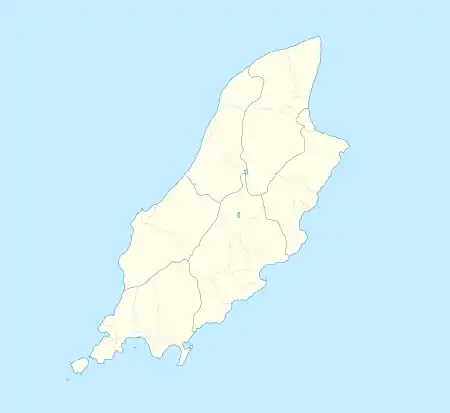| Snaefell | |
|---|---|
| Sniaull | |
 | |
| Highest point | |
| Elevation | 2,037 ft (621 m) |
| Prominence | 2,037 ft (621 m) |
| Parent peak | none – HP Isle of Man |
| Listing | Marilyn, Hardy |
| Coordinates | 54°15′47.8″N 04°27′41.8″W / 54.263278°N 4.461611°W |
| Naming | |
| English translation | snow fell |
| Language of name | Old Norse |
| Pronunciation | /ˈsneɪfɛl/ |
| Geography | |
 Snaefell Location of Snaefell in the Isle of Man | |
| Location | Isle of Man |
| OS grid | SC397881 |
| Topo map | OS Landranger 95 |
Snaefell (Old Norse: snjœ-fjall/snjó-fall – snow mountain) – (Manx: Sniaull)[1] is the highest mountain and the only summit above 2,000 feet (610 m) on the Isle of Man, at 2,037 feet (620.9 m) above sea level.[2][3] The summit is crowned by a railway station, cafe and several communications masts.
Views
It is a well-known saying in the Isle of Man that on a clear day six kingdoms can be seen from the top: the Isle of Man, England, Ireland, Scotland, Wales and Heaven.[4] Some versions add a seventh kingdom, that of Manannán (or the sea).[5]
The plaque at the summit indicates the directions of five points from Snaefell as well as their distances:
- 31 miles (50 km) to the Mull of Galloway (Scotland)
- 51 miles (82 km) to Scafell (England)
- 66 miles (106 km) to the Mountains of Mourne (Northern Ireland)
- 85 miles (137 km) to Liverpool (England)
- 97 miles (156 km) to Dublin (Republic of Ireland)
(For some reason, Wales is absent from the plaque).
While highly dependent on weather conditions and visibility, all of the four countries of the United Kingdom can be seen from the summit of Snaefell. This includes much of the southern coast of Dumfries and Galloway in Scotland, the Lake District in England, the northern coast of Anglesey in Wales, and the Mountains of Mourne in Northern Ireland. Points in the Republic of Ireland in County Louth can also be seen.[6]
Climbing Snaefell
The Snaefell Mountain Railway has a seasonal electric tram service, typically from April to October, which climbs the four miles (six kilometres) from Laxey to the summit.
The A18 Snaefell Mountain Road passes over the slopes of Snaefell, and is the highest section of the Snaefell Mountain Course over which the Isle of Man TT Races are held. Walkers often use the car park on this road near the Bungalow railway station (last railway stop before the summit) from which there is a rough path to the peak. The trail has sections of gravel, slate stones, grass and rock. While the angle of ascent steepens significantly closer to the summit, special climbing equipment is not required. However, caution is required in steep areas as the grass, earth and rocks are often slippery. Average climb time on foot on a dry footpath is about 45 minutes.
A geodetic marker embedded in the small, concrete obelisk indicates the true mountain summit. The rock cairn standing nearby has an information plaque on top.
Weather
In 1970, the automated weather station at the Snaefell summit recorded a gust of 150 mph (65 m/s) which was one of the highest wind speeds ever recorded in the British Isles.[7] During hurricane storm-force winds, the 120-foot-tall (37 m) Civil Aviation Authority radio mast at the Snaefell summit was damaged and blown down on 2 December 1966.[8]
Gallery
 Footpath entry near Bungalow railway station typically used to climb Snaefell
Footpath entry near Bungalow railway station typically used to climb Snaefell The Snaefell Mountain Railway on the ascent of Snaefell
The Snaefell Mountain Railway on the ascent of Snaefell Defunct hotel (now cafe) near the summit
Defunct hotel (now cafe) near the summit Top of Snaefell with geodetic marker and nearby cairn with plaque
Top of Snaefell with geodetic marker and nearby cairn with plaque Plaque pointing out the directions of landmarks and their distances from the summit
Plaque pointing out the directions of landmarks and their distances from the summit
References
- ↑ Place Names of The Isle of Man – Da Ny Manninee Dooie Volume Three. Sheading of Ayre (Kirk Andreas, Kirk Bride and Kirk Christ Lezayre) page 464 Kirk Christ Lezayre by George Broderick – Tübingen; Niemeyer NE:HST (1997) Manx Place-Name Survey, Max Niemeyer Verlag Türbingen ISBN 3-484-40138-9 (Gesamtwerk) 3-484-40131-1 (Band 3) Druck: Weihert-Druck GmbH Darmstadt Einband: Siegfried Geiger, Ammerbuch. "A mountain summit ct. SC38NE SC39788811"
- ↑ "Ordnance Survey Triangulation stations trig archive". Retrieved 17 October 2016.
- ↑ "Ordnance Survey mapping". Retrieved 17 October 2016.
- ↑ Isle of Man guide website
- ↑ Manx Notebook website
- ↑ "HeyWhatsThat - Snaefell panorama". www.heywhatsthat.com. Retrieved 2 November 2020.
- ↑ Birmingham Daily Post page 35 Wednesday 4 November 1970
- ↑ Birmingham Daily Post page 27 Saturday 3 December 1966
External links
- Computer generated summit panoramas North South Index
- Snaefell Mountain Railway
- Cold War RADAR Site
- Snaefell Fell Race


